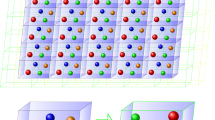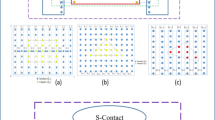Abstract
Experiments on quantum wells in tilted fields have stimulated several groups to investigate semiclassical theories for the current fluctuations. As a result, there is now a sort of “Zoo” of different types of trajectories (Periodic Orbits, Normal Orbits, Central Closed Orbits, Ghost Periodic Orbits, Saddle Orbits, Minimal Orbits) which have all been used to analyse these experimental spectra. Here we review briefly the semiclassical descriptions for this system and discuss which types of trajectories are most appropriate in those regimes where one cannot use Periodic Orbits. We conclude that using either Saddle Orbits (SOs) or Minimal Orbits (MOs) yields excellent agreement with experiment and quantal calculations. We also investigate the damping of the amplitudes of POs (or other semiclassical trajectories). In these scaling systems, different experiments on wells of variable dimensions can correspond to the same classical dynamics and even the same effective ℏ. The trajectory associated with the experimental current oscillation is unchanged: the only significant alteration is a re-scaling of the period T of the PO, affecting only the amplitude damping factors τe−T/τ due to incoherent processes in the experiment. By comparing measurements of the same period-doubling feature of the current in 85 nm and 120 nm wells we can probe the value of τ from the change in the PO (or SO/MO) amplitudes which are estimated from the experiment.
Similar content being viewed by others
REFERENCES
O. Zobay and G. Alber, ``Periodic orbits and molecular photoabsorption,'' J. Phys. B 26, L539 (1993).
B. Huppert, B. Eckhardt, and V. Engel, ``Semiclassical photodissociation cross section for H2O,'' J. Phys. B: At. Mol. Opt. Phys. 30, 3191 (1997).
D. Wintgen, ``Connection between long-range correlations in quantum spectra and classi-cal periodic orbits,'' Phys. Rev. Lett. 58, 1589 (1987).
E. B. Bogomolny and D. C. Rouben, ``Semiclassical description for resonant tunneling,'' Europhys. Lett. 43, 111 (1998); Eur. Phys. J. B 9, 695 (1999).
E. E. Narimanov, N. R. Cerruti, H. U. Baranger, and S. Tomsovic, ``Chaos in quantum dots: Dynamical modulation of coulomb blockade peak heights,'' Phys. Rev. Lett. 83, 2640 (1999).
C. Gnachl, F. Capasso, E. E. Narimanov et al., ``High power directional emission from lasers with directional emission,'' Science 280, 1556 (1998).
B. Eckhardt, S. Fishman, K. Müller, and D. Wintgen, ``Semiclassical matrix elements from periodic orbits,'' Phys. Rev. A 45, 3531 (1992).
D. S. Saraga, Ph.D. thesis, University College London (1999), www.tampa.phys.ucl.ac.uk_ tdaniel_thesis.html.
D. S.6Saraga and T. S. Montiro (in press, Nonlinearity) ``Semiclassical Gaussian matrix elements for chaotic quantum wells,'' eprint chao-dyn_9911009.
T. M. Fromhold et al., ``Magnetotunneling spectroscopy of a quantum well in the regime of classical chaos,'' Phys. Rev. Lett. 72, 2608 (1994).
G. Müller, G. S. Boebinger, H. Mathur, L. N. Pfeiffer, and K. W. West, ``Precursors and transition to chaos in a quantum well in a tilted magnetic field,'' Phys. Rev. Lett. 75, 2875 (1995).
D. L. Shepelyansky and A. D. Stone, ``Chaotic Landau level mixing in classical and quan-tum wells,'' Phys. Rev. Lett. 74, 2098 (1995).
T. S. Monteiro and P. A. Dando, ``Chaos in a quantum well in tilted fields: A scaling system,'' Phys. Rev. E 53, 3369 (1996).
P. B. Wilkinson, T. M. Fromhold, and L. Eaves, ``Observation of scarred wavefunctions in a quantum well with chaotic electron dynamics,'' Nature 380, 608 (1996).
T. S. Monteiro, D. Delande, A. J. Fisher, and G. S. Boebinger, ``Bifurcations and the transition to chaos for the resonant tunneling diode,'' Phys. Rev. B 56, 3913 (1997).
E. E. Narimanov and A. D. Stone, ``Origin of strong scarring of wave functions in quan-tum wells in tilted magnetic fields,'' Phys. Rev. Lett. 80, 49 (1998).
E. E. Narimanov, A. D. Stone, and G. S. Boebinger, ``Semiclassical theory of magneto-transport through a quantum well,'' Phys. Rev. Lett. 80, 4024 (1998).
D. S. Saraga and T. S. Monteiro, ``Quantum chaos with complex, non-periodic orbits,'' Phys. Rev. Lett. 81, 5796 (1998).
D. S. Saraga, T. S. Monteiro, and D. C. Rouben, ``Periodic orbit theory for resonant tunnelling diodes: Comparison with quantum and experimental results,'' Phys. Rev. E 58, R2701 (1998).
E. E. Narimanov and A. D. Stone, ``Quantum chaos in quantum wells,'' Physica D 131, 221 (1999).
Author information
Authors and Affiliations
Rights and permissions
About this article
Cite this article
Monteiro, T.S., Saraga, D.S. Quantum Wells in Tilted Fields: Semiclassical Amplitudes and Phase Coherence Times. Foundations of Physics 31, 355–370 (2001). https://doi.org/10.1023/A:1017546721313
Issue Date:
DOI: https://doi.org/10.1023/A:1017546721313




